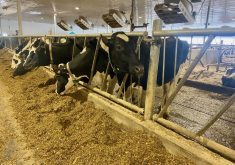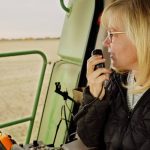BIGGAR, Sask. – Cathy Fenwick recommends that everyone have a first aid kit with the main ingredient being laughter.
She picks up a pink plastic pig that fits in the hand and gives it a squeeze. It giggles. That’s a part of her own kit.
She pops on a red clown nose and Groucho Marx-style glasses with bushy eyebrows. Nobody can look serious in these.
Fenwick teaches people the art of finding joy, and in an agricultural industry rocked by drought, grasshoppers and bovine spongiform encephalopathy, humour is an important commodity.
Read Also

Farmland ownership fires up Saskatchewan politicians
Saskatchewan politicians debate the enforcement of farmland ownership laws in the province.
“There are so many things in life that interfere with joy,” said Fenwick, a Regina psychologist and consultant. That is why she encourages people to actively search for laughs.
“It’s the best stress buster there is.”
In an interview before Fenwick’s speech to an audience of 170 rural women at a Jan. 17 conference in Biggar, Sask., she said, “I admire farmers so much for their double job – feeding the world and keeping their farms. It’s a lot of work to keep the lifestyle they want.”
Children are naturally happy, she said, and older people, who know the value of humour to fend off life’s losses, have learned how to bring it out. It’s the middle ages where people must learn how to find laughter.
“How will despair help the situation? We have to keep hope alive. Have the inner strength and hope and take action, whether that’s doing something else other than farming.”
People have choices, she told the group. They can change their attitude or change their work. She said farmers should acknowledge how important their job is, avoid fear mongering and connect spiritually to achieve inner peace.
She quoted a favourite saying: “If I can talk, I will sing. If I can walk, I will dance. If I can laugh, I will survive.”
Conference organizer Jean Itterman said Fenwick’s audience picked up on her lesson.
“It was super. It was still bubbling over Sunday morning in church,” she said.
“We had four people volunteer to come on the organizing committee. I’ve never seen that before. We start work next month on next year’s conference.”
This was the second year the town held the conference. Itterman said such mid-winter breaks are not common in the province because it takes money and a working committee to pull them off. Funding for this event came from local service clubs and businesses, as well as the Saskatchewan agriculture department, the regional college and the health region.
The day began with a fashion show of comfortable and warm outfits, followed by a talk about being too busy from a Rockhaven, Sask., farmer and consultant and another about diet and fitness from public health nutritionist Sheri Taylor.
Taylor talked about the appeal of the low-carbohydrate, high-protein diet, which encourages people to eat meat, fish, cheese and salads, but no dairy products, fruit, bread, pasta, rice or common vegetables such as carrots, corn and peas. While these diets have a rapid initial weight loss – mainly water – Taylor had several criticisms.
The main problem is that the diet rules out half of the food groups, which will result in nutritional deficiencies. People also tend to become dehydrated, tired and irritable and risk health problems because of the high-protein content.
Taylor laid out her rules for a better approach: eat only when you’re hungry; stop when you feel full; don’t eat while your mind is distracted by driving or TV; be physically active and eat low glycemic foods that help regulate blood sugar levels, such as oatmeal, pasta and brown rice.














